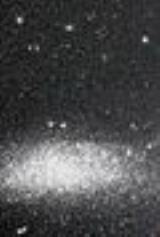
Wolf-Lundmark-Melotte
Encyclopedia
The Wolf-Lundmark-Melotte (WLM) galaxy
is an irregular galaxy
discovered in 1909 by Max Wolf
, and is located on the outer edges of the local group
. The discovery of the nature of the galaxy was accredited to Knut Lundmark
and Philibert Jacques Melotte
in 1926. It is in the constellation
Cetus
.
to create a color-magnitude diagram for WLM. It showed that around half of all the star formation
in this galaxy occurred during a burst that started ~13 Gyr ago. During the burst, the metallicity
of WLM rose from [Fe/H] ~ -2.2 to [Fe/H] -1.3. There being no horizontal-branch population, Dolphin concludes that no more than ~20 M☉
per Myr of star formation occurred in the period from 12 to 15 Gyr ago. From 2.5 to 9 Gyr ago, the mean rate of star formation was 100 to 200 M☉ per Myr.
that Hodge et al. (1999) determined has Mv = -8.8 and [Fe/H] = -1.5 with an age of ~15 Gyr. This cluster has a luminosity that is slightly over the average for all globulars. The seeming lack of faint low-mass globular clusters can not be explained by the weak tidal forces of the WLM system.
Galaxy
A galaxy is a massive, gravitationally bound system that consists of stars and stellar remnants, an interstellar medium of gas and dust, and an important but poorly understood component tentatively dubbed dark matter. The word galaxy is derived from the Greek galaxias , literally "milky", a...
is an irregular galaxy
Irregular galaxy
An irregular galaxy is a galaxy that does not have a distinct regular shape, like a spiral or an elliptical galaxy. The shape of an irregular galaxy is uncommon – they do not fall into any of the regular classes of the Hubble sequence, and they are often chaotic in appearance, with neither a...
discovered in 1909 by Max Wolf
Max Wolf
Maximilian Franz Joseph Cornelius Wolf was a German astronomer and a pioneer in the field of astrophotography...
, and is located on the outer edges of the local group
Local Group
The Local Group is the group of galaxies that includes Earth's galaxy, the Milky Way. The group comprises more than 30 galaxies , with its gravitational center located somewhere between the Milky Way and the Andromeda Galaxy...
. The discovery of the nature of the galaxy was accredited to Knut Lundmark
Knut Lundmark
Knut Emil Lundmark was a Swedish astronomer, professor of astronomy and head of the observatory at Lund University 1929–1955....
and Philibert Jacques Melotte
Philibert Jacques Melotte
Philibert Jacques Melotte was a British astronomer whose parents immigrated from Belgium.In 1908 he discovered a moon of Jupiter, today known as Pasiphaë. It was simply designated "Jupiter VIII" and was not given its present name until 1975.The asteroid 676 Melitta, the only one he discovered, is...
in 1926. It is in the constellation
Constellation
In modern astronomy, a constellation is an internationally defined area of the celestial sphere. These areas are grouped around asterisms, patterns formed by prominent stars within apparent proximity to one another on Earth's night sky....
Cetus
Cetus
Cetus is a constellation. Its name refers to Cetus, a sea monster in Greek mythology, although it is often called 'the whale' today. Cetus is located in the region of the sky that contains other water-related constellations such as Aquarius, Pisces, and Eridanus.-Ecliptic:Although Cetus is not...
.
Star formation
In 1994, A. E. Dolphin used the Hubble Space TelescopeHubble Space Telescope
The Hubble Space Telescope is a space telescope that was carried into orbit by a Space Shuttle in 1990 and remains in operation. A 2.4 meter aperture telescope in low Earth orbit, Hubble's four main instruments observe in the near ultraviolet, visible, and near infrared...
to create a color-magnitude diagram for WLM. It showed that around half of all the star formation
Star formation
Star formation is the process by which dense parts of molecular clouds collapse into a ball of plasma to form a star. As a branch of astronomy star formation includes the study of the interstellar medium and giant molecular clouds as precursors to the star formation process and the study of young...
in this galaxy occurred during a burst that started ~13 Gyr ago. During the burst, the metallicity
Metallicity
In astronomy and physical cosmology, the metallicity of an object is the proportion of its matter made up of chemical elements other than hydrogen and helium...
of WLM rose from [Fe/H] ~ -2.2 to [Fe/H] -1.3. There being no horizontal-branch population, Dolphin concludes that no more than ~20 M☉
Solar mass
The solar mass , , is a standard unit of mass in astronomy, used to indicate the masses of other stars and galaxies...
per Myr of star formation occurred in the period from 12 to 15 Gyr ago. From 2.5 to 9 Gyr ago, the mean rate of star formation was 100 to 200 M☉ per Myr.
Globular cluster
WLM has one known globular clusterGlobular cluster
A globular cluster is a spherical collection of stars that orbits a galactic core as a satellite. Globular clusters are very tightly bound by gravity, which gives them their spherical shapes and relatively high stellar densities toward their centers. The name of this category of star cluster is...
that Hodge et al. (1999) determined has Mv = -8.8 and [Fe/H] = -1.5 with an age of ~15 Gyr. This cluster has a luminosity that is slightly over the average for all globulars. The seeming lack of faint low-mass globular clusters can not be explained by the weak tidal forces of the WLM system.

